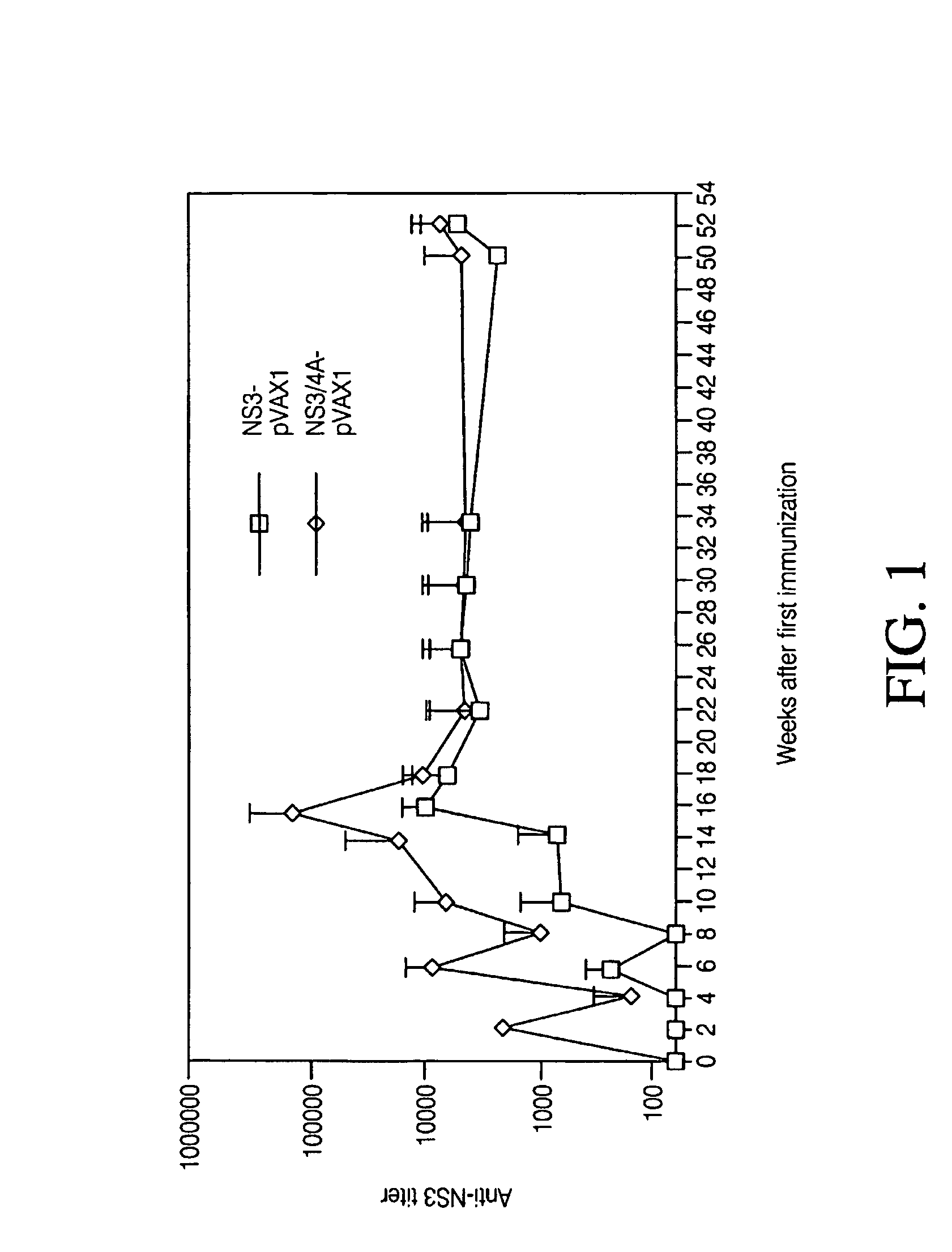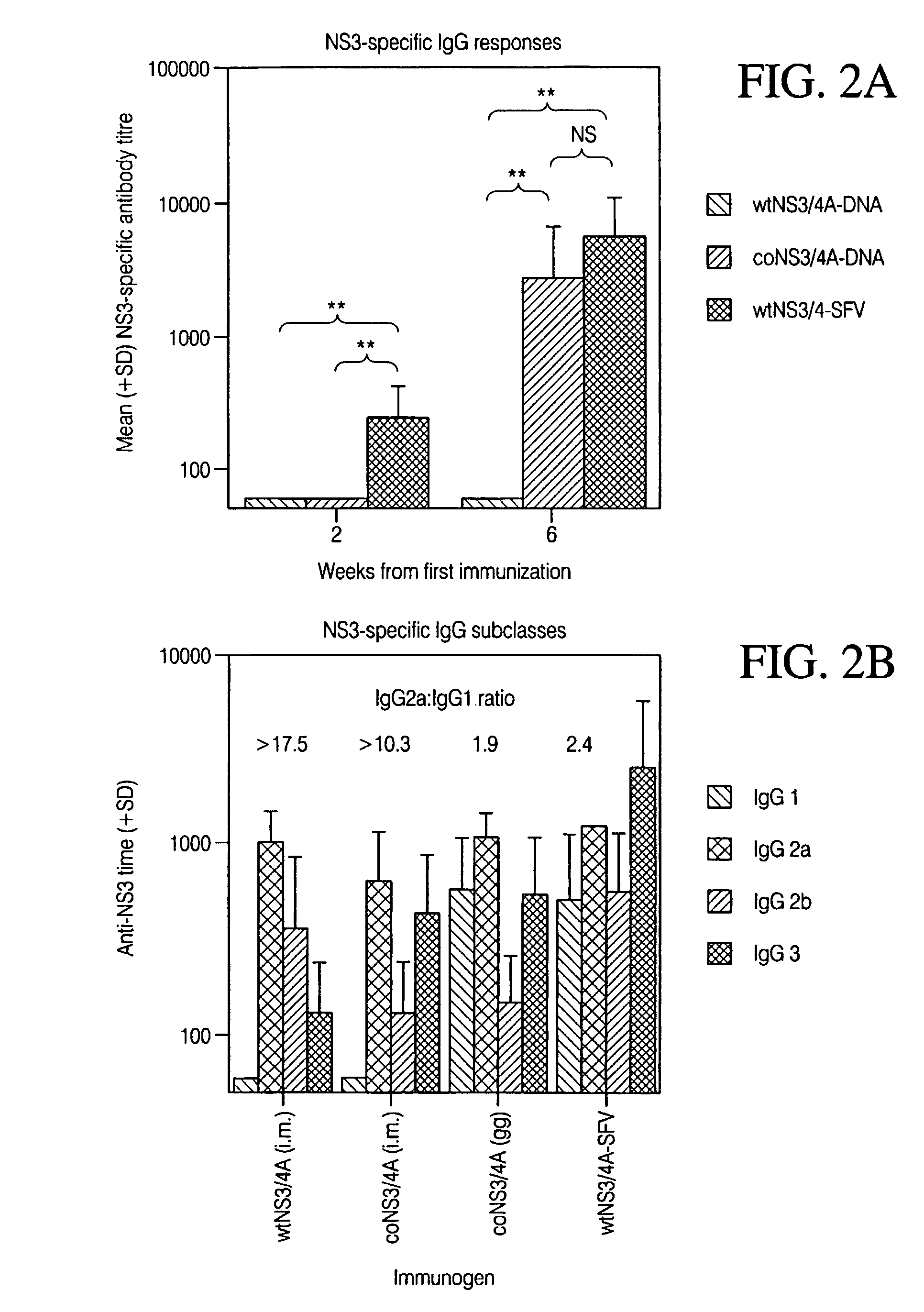Transgenic mouse models of hepatitis C virus (HCV) and identification of HCV therapeutics
a mouse model and hepatitis c virus technology, applied in the field of transgenic mouse models of hepatitis c virus and identification of hcv therapeutics, can solve the problems of difficult creation of an animal model for hcv infection, complex goal, and failure to prevent the establishment of chronic diseases, so as to reduce sensitivity, increase resistance to tnf-alpha, and reduce the effect of sensitivity
- Summary
- Abstract
- Description
- Claims
- Application Information
AI Technical Summary
Benefits of technology
Problems solved by technology
Method used
Image
Examples
example 1
[0257]The NS3 / 4A sequence was amplified from the serum of an HCV-infected patient (HCV genotype 1a) using the Polymerase Chain Reaction (PCR). Total RNA was extracted from serum, and cDNA synthesis and PCR were performed according to standard protocols (Chen M et al., J. Med. Virol. 43:223-226 (1995)). The cDNA synthesis was initiated using the antisense primer “NS4KR” (5′-CCG TCT AGA TCA GCA CTC TTC CAT TTC ATC-3′ (SEQ. ID. NO.: 28)). From this cDNA, a 2079 base pair DNA fragment of HCV, corresponding to amino acids 1007 to 1711, which encompasses the NS3 and NS4A genes, was amplified. A high fidelity polymerase (Expand High Fidelity PCR, Boehringer-Mannheim, Mannheim, Germany) was used with the “NS3KF” primer (5′-CCT GAA TTC ATG GCG CCT ATC ACG GCC TAT-3′ (SEQ. ID. NO.: 29) and the NS4KR primer. The NS3KF primer contained a EcoRI restriction enzyme cleavage site and a start codon and the primer NS4KR contained a XbaI restriction enzyme cleavage site and a stop codon.
[0258]The ampl...
example 2
[0269]This example showed that the NS3 / 4A proteins could be correctly translated from the wtNS3 / 4A and coNS3 / 4A plasmids. To ensure that the wtNS3 / 4A and coNS3 / 4A genes were intact and could be translated, an in vitro transcription assay is using the prokaryotic T7 coupled reticulocyte lysate system (TNT; Promega, Madison, Wis.) was performed as previously described (Lazdina U et al. J Gen Virol 2001; 82:1299-1308 (2001); Frelin L et al., Gene Ther., 10:686-699 (2003)). To compare the translation efficiency from the two plasmids the amount input DNA was diluted in serial dilutions (6 ng to 1 ng) prior to addition to the TNT assay. The results showed that the coNS3 / 4A plasmid gave detectable NS3 and NS3 / 4A protein at a higher plasmid dilution than the wtNS3 / 4A plasmid (See FIGS. 1A and 1B).
[0270]To compare the expression levels by another approach, HepG2 cells were transiently transfected with the wtNS3 / 4A and the coNS3 / 4A plasmids. The HepG2 cells were transiently transfected by sta...
example 3
[0273]To determine whether a humoral immune response was elicited by the NS3-pVAX and NS3 / 4A-pVAX vectors, the expression constructs described in Example 1 were purified using the Qiagen DNA purification system, according to the manufacturer's instructions and the purified DNA vectors were used to immunize groups of four to ten Balb / c mice. The plasmids were injected directly into regenerating tibialis anterior (TA) muscles as previously described (Davis et al., Human Gene Therapy 4(6):733 (1993)). In brief, mice were injected intramuscularly with 50 μl / TA of 0.01 mM cardiotoxin (Latoxan, Rosans, France) in 0.9% sterile NaCl. Five days later, each TA muscle was injected with 50 μl PBS containing either rNS3 or DNA.
[0274]Inbred mouse strains C57 / BL6 (H-2b), Balb / C(H-2d), and CBA (H-2k) were obtained from the breeding facility at Möllegard Denmark, Charles River Uppsala, Sweden, or B&K Sollentuna Sweden. All mice were female and were used at 4-8 weeks of age. For monitoring of humoral...
PUM
 Login to View More
Login to View More Abstract
Description
Claims
Application Information
 Login to View More
Login to View More - R&D
- Intellectual Property
- Life Sciences
- Materials
- Tech Scout
- Unparalleled Data Quality
- Higher Quality Content
- 60% Fewer Hallucinations
Browse by: Latest US Patents, China's latest patents, Technical Efficacy Thesaurus, Application Domain, Technology Topic, Popular Technical Reports.
© 2025 PatSnap. All rights reserved.Legal|Privacy policy|Modern Slavery Act Transparency Statement|Sitemap|About US| Contact US: help@patsnap.com



